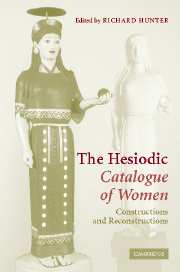Book contents
- Frontmatter
- Contents
- Notes on contributors
- Acknowledgements
- List of abbreviations
- Introduction
- 1 Ordering women in Hesiod's Catalogue
- 2 The beginning and end of the Catalogue of Women and its relation to Hesiod
- 3 Gods among men? The social and political dynamics of the Hesiodic Catalogue of Women
- 4 Heracles in the Hesiodic Catalogue of Women
- 5 Mestra at Athens: Hesiod fr. 43 and the poetics of panhellenism
- 6 A catalogue within a catalogue: Helen's suitors in the Hesiodic Catalogue of Women (frr. 196–204)
- 7 Pulp epic: the Catalogue and the Shield
- 8 The Megalai Ehoiai: a survey of the fragments
- 9 Ordered from the Catalogue: Pindar, Bacchylides, and Hesiodic genealogical poetry
- 10 The Hesiodic Catalogue and Hellenistic poetry
- 11 From genealogy to Catalogue: the Hellenistic adaptation of the Hesiodic catalogue form
- 12 The Hesiodic Catalogue of Women and Latin poetry
- 13 Or such as Ovid's Metamorphoses …
- Bibliography
- Index of passages discussed
- General index
6 - A catalogue within a catalogue: Helen's suitors in the Hesiodic Catalogue of Women (frr. 196–204)
Published online by Cambridge University Press: 22 September 2009
- Frontmatter
- Contents
- Notes on contributors
- Acknowledgements
- List of abbreviations
- Introduction
- 1 Ordering women in Hesiod's Catalogue
- 2 The beginning and end of the Catalogue of Women and its relation to Hesiod
- 3 Gods among men? The social and political dynamics of the Hesiodic Catalogue of Women
- 4 Heracles in the Hesiodic Catalogue of Women
- 5 Mestra at Athens: Hesiod fr. 43 and the poetics of panhellenism
- 6 A catalogue within a catalogue: Helen's suitors in the Hesiodic Catalogue of Women (frr. 196–204)
- 7 Pulp epic: the Catalogue and the Shield
- 8 The Megalai Ehoiai: a survey of the fragments
- 9 Ordered from the Catalogue: Pindar, Bacchylides, and Hesiodic genealogical poetry
- 10 The Hesiodic Catalogue and Hellenistic poetry
- 11 From genealogy to Catalogue: the Hellenistic adaptation of the Hesiodic catalogue form
- 12 The Hesiodic Catalogue of Women and Latin poetry
- 13 Or such as Ovid's Metamorphoses …
- Bibliography
- Index of passages discussed
- General index
Summary
INTRODUCTION
The Hesiodic catalogue of Helen's suitors (frr. 196–204) is of seminal importance for the whole stream of epic tradition: by narrating the events which led to the marriage of Helen and Menelaus, it serves as a prelude to – and an integration of – the facts narrated in the Cypria, which in turn provides detailed information on the events which led to the Trojan War. In spite of all the features it shares with the early stage of the Trojan epics and with the Homeric Catalogue of Ships, and although scholarly interest in the epic cycle has steadily increased in recent years, the Catalogue of Suitors has been given little attention so far; in fact, it has not been commented upon since the papyrus fragments were published by Wilamowitz about a century ago.
According to Merkelbach and West, the catalogue of Helen's suitors was located in the fifth and last book of the Hesiodic Catalogue. Because of its subject-matter, it can safely be treated as a separate section, independent of the rest of the Catalogue. Frr. 196–204 deal with the list of Helen's suitors, with the oath imposed upon them by Tyndareus that they would join in arms against anyone who might take Helen by force, and with her marriage to Menelaus and the birth of Hermione. We are then faced with an abrupt switch in the text (fr. 204.95–123), referring to the gods and to Zeus's intention to trigger the Trojan War, with the aim of destroying the generation of the demigods.
- Type
- Chapter
- Information
- The Hesiodic Catalogue of WomenConstructions and Reconstructions, pp. 118 - 152Publisher: Cambridge University PressPrint publication year: 2005
- 46
- Cited by



